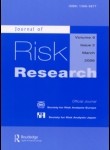 From Tech Today (October 1, 2014)
From Tech Today (October 1, 2014)
Professor Barry D. Solomon (SS) published a paper, “The Utmost Ends of the Nuclear Fuel Cycle: Finnish Perceptions of the Risks of Uranium Mining and Nuclear Waste Management,” in the Journal of Risk Research, Vol. 17, No. 8 (September 2014), pp. 1037-1059. It was coauthored with Tappio Litmanen and Mika Kari of the University of Jyväskylä, Finland.
There has been substantial social scientific research to determine how people perceive the risks of nuclear power, wastes, and waste management, but not much attention has been given to risk perceptions of other types of nuclear activities. Knowledge about attitudes towards uranium mining and exploitation is increasing, and more attention should be paid to how people perceive the risks of both ends of the nuclear fuel cycle. Therefore, the aim of this paper is to analyze the risk perceptions towards nuclear waste and uranium mining and how these perceptions relate to each other. The analysis is based on Finnish survey data (N = 1180) gathered in 2007. Renewed international interest in nuclear power raised the price of uranium from 2005 to 2007. International mining companies started uranium explorations in Finland because Finnish bedrock is the oldest in Europe, and it is similar to and of the same age as that of the major foreign uranium producers and exporters. Changes in Finnish nuclear power policy make this study timely: while the site for a spent nuclear fuel repository in Eurajoki was chosen in 2001, in 2010, two companies were selected to construct two new nuclear power reactor units in the country. Cross-tabulation of a series of contingency tables based on the survey was used to explore a diversity of nuclear risk perception views. We found that the perception of risks of nuclear waste is quite diversified and that there is no any clear linkage between nuclear waste attitudes and uranium mining attitudes. Although we found that there is a group of double risk deniers and a group of double risk perceivers, risk attitudes cannot be derived automatically from the attitudes towards either end of the nuclear fuel cycle.